News
Bright And Clean Or Soft And Inviting? Using Smart Lighting And Color Temperature To Bring Your Decor To Life April 26, 2017 00:00
The world of lighting aesthetics can be broken down into a few different characteristics.
You’ve got the design and appeal of the fixture itself, the functionality of the light (static brightness or dimmable), and the actual type of light produced such as color and color temperature.
And while it’s crucial to ensure your lighting options are both attractive and flexible, the third characteristic is really the most important when it comes to setting the mood of a space.
Cool vs. Warm Lighting: What’s the difference?
Image by Festoon Lighting Adelaide
There are a couple of options when it comes to trying to determine what kind of light will really reflect the personality you’re looking for.
One of the newest innovations in lighting is using color psychology to help control the feel of your home, a technique which is becoming even easier to take advantage of thanks to the rise of color changing smart bulbs.
Another option is using color temperature to cater to your desired design scheme. Color temperature isn’t new to the interior decorating industry. In fact, choosing the right kind of bulb has always been one of the most important steps in determining how your home should look and feel.
This critical aspect of lighting is used to describe the color of the light produced by a fixture. It ranges from yellowish light (warm) to blueish light (cool).
(Image by Holek via Wikimedia)
In the past, warm color temperature used to only come from incandescent bulbs and candles while a cool color temperature light was produced by fluorescent and LED bulbs.
As lighting technology has advanced though, you can now find a lot of bulbs that cross these lines, from incandescents that give off cool blue light, to LEDs that specialize in producing a warm yellow glow.
The trick is matching the type of light you want to the Kelvin that each bulb gives off, usually indicated somewhere on the packaging. The scale shown above will give you a good idea of what kind of light is produced by a bulb.
Using color temperature in your interior design
Now that you know the basics about color temperature we can get into what a masterfully chosen bulb can do for your design scheme.
You see, each type of light carries with it a different feel. Warm light, for instance, tends to help you and your guests feel safe and comfortable. It can help create a restful setting where conversation flows and, given the right company, romance can bloom.
The restaurant setting pictured below has created a cozy atmosphere with their lighting that lends itself well to intimacy, relaxation, and luxury.
Cool lighting on the other hand tends to add a bit of sleekness to a room’s feel. The crisp bright whites and blues of higher temperature lighting gives a sense of freshness to a space that warm lighting simply can’t.
While the burst of purple and the interesting design of the overhead light tend to draw the eye first, the room pictured below is a great example of how cool lighting contribute to the feeling of cleanliness and modernity of the space.
Mixing and matching
For the most part, warm and cool lighting have been used exclusively for traditional and modern design respectively. The relaxed, inviting nature of warm lighting matches well with the similar atmosphere of traditional design and the clean bright feel of cool lighting lends itself well to modernity.
But just because you are going for a more traditional design scheme doesn’t mean you can’t employ cool lighting to alter the feel of your home. The kitchen pictured below, for instance, incorporates elements of wood in the chairs and island along with iron overhead lighting, but bathes the room in cool bright light. And it still looks great!
It can go the other way too. The living room pictured below, for example, is a great indicator of how a modern design scheme (with the black and white colors and contemporary décor) can still feel warm and inviting given the right kind of lighting.
So don’t be afraid to mix and match. The examples above show that with a bit of tweaking, you can pull it off!
One of the best ways you can play with your design is by investing in light bulbs that not only have variable brightness settings (like built-in dimmers) but also that have the ability to change their color temperature output.
That way you don’t need to keep running back to the store for a bulb with a different color temperature.
Set the mood with smart lighting
How has your design benefited from changing your lighting’s color temperature? Do you have any tips for incorporating color temperature into your décor? Let us know in the comment section below and use color temperature to your advantage with the Flux Smart product line!
Color Psychology And Smart Lighting: Setting The Mood With Interior Design April 19, 2017 00:00
Color psychology—it’s not just a trendy term or year-long fad.
In fact, businesses across the world have been using the study of how colors affect our mood, emotions, and (most importantly to companies) our spending habits.
When it comes to branding, for example, choosing just the right color to communicate your corporate values can mean the difference between attracting your perfect customer or alienating them entirely.
But the usefulness of color psychology doesn’t end with the business big-wigs.
Take interior design for instance. Although the interplay of hues and shades is crucial, knowing how to incorporate color psychology into your home’s décor can give any space that extra special something that your guests just can’t put their finger on—but they’re sure to love.
Color Psychology: How does it work?
In order to wield the power of color psychology for your interior design effectively, you first need to know a bit about how the concept works. After all, painting a masterpiece takes more than just picking up the paintbrush.
Color psychology is a bit more complex than simply “red means love” or “green corresponds with greed.” While it’s true that some people might make such associations, how any one person subconsciously responds to a color depends on a whole host of factors, from culture and location to past experiences and even the weather.
That being said, there is quite a bit of science out there that points to the general effect each color can have. As such, we’ve put together a quick list of the most commonly used colors and how they can tap into the subconscious mind.
RED – The boldest of the colors, red has been known to not only have an impact on an individual’s appetite, it can also help to paint things in a more urgent light.
BLUE – Calm and peaceful, blue has been used by many large companies for the sense of security it provides. Blue light has also been shown to increase productivity
PURPLE – Purple’s effects are directed at the creative mind. Whether it’s solving complex logistical problems or deciding on the twist in your next chapter, this hue will help harness your creative energies.
GREEN – Because this color is especially easy on the eyes (it really does cause the least amount of eye strain!), it’s ideal for creating harmony and peace.
ORANGE & YELLOW – If there’s ever been a more joyful color than orange and yellow, we have yet to find it. These two hues are particularly great at adding a bit of optimism to your day.
While it’s worth mentioning again that not everyone will have the exact same reactions to each color, the consensus seems to be that the attributes above are pretty common among most of the public.
Color psychology and interior design
So, now that you know the specifics of these hues, let’s have a look at how you can take advantage of each when it comes to planning out your home’s décor.
Before moving on to the color specifics, one tip in particular should be noted: interior design isn’t limited just to the paint on the walls. It can include everything from furniture and hangings down to accent lighting and even paper weights! So, don’t feel limited with your décor options. Even a single well-selected accent pillow can change the entire personality of a space.
Beyond that, it’s important to stick to design principles 101. A lack of complimentary colors, mismatching shades and tones, and ultra-bright of colors are all basic pitfalls that even color psychology can’t overpower.
Now, let’s move on to how to use color psychology to bring your interior design to life.
RED – Stimulating conversation and a satisfying eating experience can both flourish when surrounded by this particular color. As such, look to add a bit of it to where people tend to gather most like the family room and of course to the main dinner spaces like the kitchen or dining room.
BLUE – The cool and collected security of this color can do wonders to help you melt the stress away and get ready for relaxation. Try sprinkling your bedroom or living room with a touch of blue or go all out and create an entire accent wall in the hue.
PURPLE – Imagination especially shines with this shade. Use it to get your creative juices flowing in your studio or wherever you solve problems and engage with any form of art like the study.
GREEN – A particularly calming color, green is a good place to start when trying to plan out your home office’s décor. The lack of eye strain it creates can help you concentrate in small details for longer than normal (hence the green eye shades and lamps for accountants).
ORANGE & YELLOW – If you really want to pump yourself up to finally make use of your exercise room, try giving it a bit of orange or yellow flair. The stimulation might make it easier to feel enthused about tackling another mile on the treadmill.
Let us know what you think!
Do you have any other color psychology design tips to share? How has incorporating these awesome techniques helped to bring your décor to life? Let us know in the comment section below and start using color to your advantage with the Flux Smart product line!
Make Your Colors Pop With These Simple Lighting Tips April 12, 2017 00:00
The grass is beginning to turn a healthy green, the air is perfumed with blooming fragrances, and the world around us is bursting with color again. Spring is upon us.
We can finally shrug off the monotony of winter and embrace the bright and lively colors of the season! Isn’t it amazing what a little bit of color can do for your mood?
This season, don’t let the outdoors be the only place to find some color in your day. Instead, follow the simple lighting tips below to help bring your decorative hues to life.
Harness the power of accent lighting
If you could only take away a single lighting tip from this post, then this would be the one to keep. Accent lighting is one of the best ways to add flair and character to a living space. It can be used to highlight architectural designs, particularly striking décor, and can even act as a design piece itself!
Here’s how:
Accent lighting is one of three types of lighting used in interior design. The other two, ambient and task lighting, are mainly related to function rather than decoration. And while both of these might make it easier to move around a room or perform actions like reading a book, accent lighting defines the feel of a room because the eye naturally falls on the brightest part.
If you really want to make your colors pop then, try adding some accent lighting that highlights especially colorful design elements. It could be a sculpture, a painting, or even a bookcase with some brightly colored covers. You might be surprised at how much different a space feels afterwards!
Invest in color-changing light bulbs
While the color-changing light bulbs of the past used to be reserved for parties, holidays, and kid’s rooms, modern smart bulbs with this feature have become a staple in the world of interior design.
There are a couple of reasons why.
First, these bulbs offer something no other bulb can—light that comes in 16 million different colors. With such an enormous range, you don’t have to choose just from “loud” colors. In fact, one of the best ways you can use these bulbs is by just adding a little bit of color to your light.
Maybe a light green to help you usher in spring.
Or a pinch of red to add a bit of relaxation.
Whatever color you go with, bathing your living space in a certain hue can transform a boring interior design scheme into a layout you and your guests will love.
Color-changing bulbs also offer the benefit of making your accent lighting pop even more. Imagine walking into a living room and seeing not just a few brightly lit objects but rather a burst of colored light enveloping them as well.
Warm or cool?
Light color temperature is one of the biggest contributors to wrongly chosen color schemes. You may be browsing the hardware store for a reasonable looking paint swatch when BAM! It hits you. That absolutely perfect hue that will do wonders to tie your family room together. So, you buy a can of it. In fact, you buy three (that color is so perfect!).
But after you cover the entire space in this color you thought was sent directly from the heavens, you realize that something isn’t quite right. The hue you were fawning over for so long has changed from absolutely perfect to, well, this.
What happened?
You might be suffering from the common problem of misjudging how a color will look in a different light. You see, the lights of a hardware store, while bright and effective, might have a different color temperature than the lights in your home. As a result, the colors in your family room are bound to look different when illuminated by a dissimilar kind of light.
While some paint specialty shops have displays set up to show just how light color temperature might alter your favorite hue, one of the best ways to ensure your colors look just right is by having a light source with an adjustable color temperature. That way, you can cater your lighting needs to that perfect color rather than the other way around.
Now that’s what we call versatility.
Let us know what you think!
What other ways have you found lighting can really help your home’s colors pop? How have using these design tips changed the look and feel of your home? Let us know in the comment section below and get coloring with the Flux Smart product line!
Easter Décor Galore! (And How Smart Bulbs Can Give You Even More) April 5, 2017 00:00
Few occasions bring families and friends together like Easter.
It could be the mix of festivity and reverence. Or it may be the joy of decorating eggs and the thrill of hunting for them Sunday morning. Or maybe it’s all the chocolate, jelly beans, and sugar covered marshmallows that really make this holiday shine.
No matter what Easter might mean to you, one thing is for sure: Easter is and always has been one of the most cheerful holidays on the calendar. And if you’re decorating your home for this occasion, you’re probably thinking of ways to communicate that same joyous feeling.
So, the question is: how can you spruce up your home to match the bright and beautiful Easter season this year?
That’s why we’ve put together this list of a few tricks to really get your home into the spirit. The decorations, design tips, and a couple ways to take advantage of your smart bulbs provided below will all help make your Easter a particularly festive occasion.
Embrace the entryway
You’ve heard the old saying, “you never get another chance to make a first impression.” Well the same goes for your home. And if you are trying to Easter-ize your home this holiday season, one of the best ways to do that is by focusing on the entryway.
A few tastefully designed Easter knick-knacks on the console tables of your home’s entrance is a good start. Be sure not to overload it of course! Sometimes simplicity is the best route, especially when the design elements may already have a predisposition to kitsch (we’re looking at you Easter Bunny).
When it comes to the outdoors, a nice Easter wreath can be a great way to set the mood for your home but frankly, we’ve all seen that before. By all means keep the wreath but if you want to exude holiday spirit this year, you may want to try something different as well.
For instance, anyone with white or lace curtains can use their smart bulbs to add a bit more Easter panache to their home this year. All it takes is setting your smart bulbs to shine the lavenders, yellows, and pinks of Easter directly onto the curtains.
To pull this one off (and when you do, it’s worth it!) it takes a bit of subtlety with the colors. Truly go pastel on this one. If you go the route of lemon yellow, tickle me pink, and violet it might be a bit overwhelming for both you and your neighbors. And if you find those perfect hues you could even cycle between the colors for some truly dynamic decorations!
A superior Easter interior
As for the indoor décor, feel free to be a little bit bolder with your design. Here you can pepper in a few bright accents that play well against an unimposing interior. And if you’re not fully onboard with buying a violet sectional couch (we don’t blame you), you could keep your accents down to a more manageable level with, say, a few eye-catching lavender pillows or a sage-green blanket to help bring in the season.
These quick but powerful bursts of color here and there are known in the design world as “accents”. While an accent might be small compared to the rest of your interior, they can truly transform the character of an entire room, even an entire home!
And when it comes to accents, nothing works better than adding an accent light. You see, a well-lit home is made up of three different types of light: ambient, task, and accent. While ambient is your all-purpose and functional source for illumination and task lighting helps you perform, well, tasks (think under-cabinet lighting in the kitchen), accent lighting really dictates the feel of a room by highlighting interesting design elements and décor.
While an accent light can normally only do as much for a room as the decoration it’s highlighting, a smart bulb can actually make the light itself become the point of interest. Instead of just brightening up your bookcase, painting or clock, use the smart bulb’s color changing ability to cast these objects in a whole new light, literally!
Try playing with your lighting colors throughout the house. As we pointed out earlier though, just a little bit of color can go a long way when it comes to lighting. And with over 16 million different colors to choose from, you’re bound to find one that perfectly complements your Easter style.
Let us know what you think!
What kinds of creative decorating techniques do you use to celebrate Easter? How has the 16 million choosable colors and dimming ability of smart bulbs helped you spruce up your home this year? Let us know in the comment section below and celebrate Easter with the Flux Smart product line!
Smart Bulb Alexa Integration: A Big Step Towards a Smarter Home March 29, 2017 00:00

Remember The Jetsons?
“Meet George Jetson… His boy Elroy… Daughter Judy… Jane, his wife!”
If you’re like most people, you’ve probably got images of that neat flying car that turns into a suitcase flashing through your head right about now. Or maybe their robotic housemaid Rosie and their talking dog Astro (what is it about talking dogs in cartoons anyway?).
Definitely a classic!
One aspect of that show that captured the imagination and attention of its viewers was the imaginative technology of the future, always a popular draw for an audience.
When the show first aired, most of those technologies were thought to be a long way off. And while we still don’t have flying cars (what’s taking so long car companies?), the smart home from the show is becoming more of a reality with each passing day thanks to the Internet of Things.
Better yet, smart personal assistants like the immensely popular Alexa by Amazon let you control many of your connected devices with simple voice commands.
And now, your Flux Smart light bulbs offer full Alexa integration! Before getting into the specifics of how to use Alexa to control your home’s lighting, let’s take a quick look at the growing trend of the smart home and why products like Alexa are such a great step in the right direction.

The smart home and Alexa
So, what exactly is a smart home?
You’ve undoubtedly noticed that a lot of products can now connect directly to your phone or computer. This lets you control the device remotely, customize it to meet your needs, or monitor it from anywhere in the world.
It can mean a coffee brewer that you can turn on from bed, a thermostat that notifies you when the heat’s been turned on, and a doorbell that sends you a video feed of your visitors, even when you aren’t home!
This movement towards an increasingly connected world is called the Internet of Things. And a smart home is one that uses this type of connectivity for heating and cooling, appliance and entertainment device control, and, of course, for lighting as well.
The smart homes of the past depended for the most part on a single control device (kind of like a huge TV remote) to bring it all together.
But with the age of Alexa upon us, smart homes have reached an entirely new level of user-friendliness. Instead of having to lug that giant remote around with you wherever you go, Alexa lets anyone simply call out a request (like “turn on the heat,” “start the oven,” or even “water the lawn”) and Alexa will handle the rest.
Pretty cool, huh?
Of course, the reach of Alexa is limited entirely by whether or not a device is compatible. To find a complete list of these devices, check out this page from Amazon. You can also purchase outlet plugins that Alexa can connect to so any device can be accessed.

Alexa and Flux Smart bulbs
When you think of a futuristic home, I’m sure one of the images that pops into your head is voice activated lights. After all, almost every sci-fi movie out there lets you know you’re in the future with a scene showing a guy entering a room and saying “lights on”.
And now, anyone with Flux Smart bulbs can finally be that guy!
As of now, Alexa can respond to four separate commands:
- Alexa, set [light name] to [0-100]%
- Alexa, turn [light name] on/off
- Alexa, dim/brighten [light name]
- Alexa, increase/decrease [light name]
And when you combine that with the upcoming ability to change light colors and set custom modes using voice commands, you’re bound to have all of your lighting needs and desires completely covered!
Beyond that, setting your bulbs up to integrate with Alexa is a cinch. All it takes is four simple steps: set up a cloud account, enable remote connection, enabling the Alexa skill, and connecting the bulbs to Alexa (you can find a more detailed setup guide here).
With a painless setup and such impressive functionality, there’s no reason not to start using Alexa to control your home’s lights today.
So go on. Take a step into the future!
Let us know what you think!
How has Alexa changed your home? What do you think of Flux Smart’s smart bulb Alexa integration? Let us know in the comment section below and get futuristic with the Flux Smart product line!
Smart Bulbs: The Future Of Relaxation March 22, 2017 00:00

Stress is a killer.
We all know it, and we’ve all felt what it’s like when we have too much of it. In fact, Americans are reporting their stress levels are on the rise with over one-third of the population reporting increased stress in the past year alone.
What’s worse is the havoc too much daily stress can have on your body. From headaches and rashes to depression and heart disease, stress overload can give you a wide range of health problems (and the list goes on).
So, how can you fight off your overwhelming stress before it begins controlling your life?
Simple: by taking a minute to just relax.
Whether it’s at the end of a long shift at work or a quick fifteen minutes in the middle of your day, forcing yourself to relax is one of the best ways you can counteract stress’s harmful effects and give your body and mind some time to recoup.
And when it comes to relaxation, few things are as effective as the sensory immersion provided by smart bulbs.
But before getting into that, let’s take a closer look at how our body reacts to stress and how daily relaxation can help you.
Your body and stress
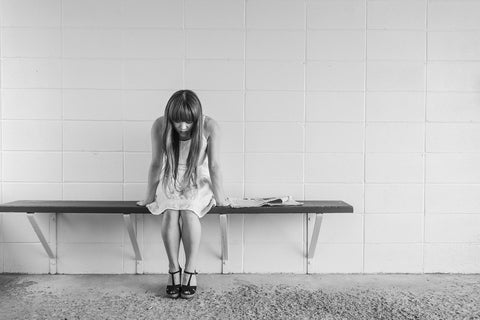
Stress is one of those things that everyone wishes they didn’t have, right up there with mosquitoes and pimples.
But the truth is, if we never felt any stress we simply wouldn’t get anything done! After all, if you truly don’t have a care in the world then what’s to stop you from skipping work and never paying taxes again?
So, while we may hate feeling it, each of us actually needs at least some stress in our lives to keep us productive.
That being said, our bodies aren’t built to handle chronic stress. While short bursts can spur us into action, long bouts of stress can really do a number on our physical health, resulting in countless discomforts and even life threatening diseases.
Beyond that, regular relaxation can provide a host of benefits including higher productivity levels, better memory, increased alertness, and being a generally happier person!
Stress relief with sensory immersion

So what’s the best way to relax in the hustle and bustle of the modern world?
That’s where sensory immersion comes in. By bathing your body’s audio and visual centers in soothing sounds and light, you give yourself over to relaxation more easily. That’s why spas and yoga retreats are often accompanied by serene decorations and lulling music: it makes it simpler to really let go.
Let’s take a quick look at the science here.
In a study by Penn State associate professor of bio-behavioral health Orfeu Buxton, researchers discovered that the mind is particularly good at relaxing with soothing sounds by comparing responses to abrupt threats (like alarm clocks) and gradual non-threats (like an approaching thunderstorm).
He found that gradual non-threats can be played almost twice as loud before getting the same response as abrupt threats. So, while you may wake up at even the slightest creak in the floorboards amidst the silence of the night, your mind can keep you relaxed enough to stay asleep even among crashes of waves, clamors of thunder, or the sharp chirps of birds.
Think of these types of sounds as a way to hack into our own minds and prime them for relaxation.
And the research doesn’t stop there.
There have been a wealth of studies on how simply looking at a relaxing picture, like that of a forest, can actually be quite effective at reducing stress and lowering the risk of depression. One study even showed that patients in intensive care could lessen their need for pain medication by looking at pictures of trees and water!
It seems, then, that one of the best ways to relax is to surround yourself with the perfect combination of light and sound…
Melt the stress away with smart bulbs

Cue smart bulbs.
If you’ve had your finger on the pulse of the light bulb industry, you already know that you can set your high-quality smart bulbs to shine out over 16 million different colors, and even create custom schemes that transition from one hue to another.
But did you know that some smart bulbs like the Flux Smart Melody come with the ability to play music and soundscapes from your phone or tablet as well?
While these nifty features can be particularly useful when it comes to throwing a rockin’ get together, you can also use the speaker and color changing abilities to set the perfect mood for you to relax in.
Just imagine coming home from a long day at the office and taking a load off in your favorite chair by listening to the soothing sound of waves on a beach and bathing yourself in cool blue light.
Feel that stress melting away yet?
With a smart bulb in hand, the power to relieve stress whenever you want is right in your smart device. Happy relaxing!
Let us know what you think!
What have you found to be an especially great way to relax? Have you used smart lighting to help take a load off? Let us know in the comment section below and de-stress your life with the Flux Smart product line!
Ushering In Spring? Think Green For Your Design Scheme March 15, 2017 00:00

Green: it’s the color of life, luxury, and new beginnings.
And now that the frigid months of winter are mostly behind us (fingers crossed), we’re all about to be seeing a lot more of it!
With flowers in bloom and the lush grass starting to finally fill in, it’s about time to give your interior design scheme a fresh new makeover to match. And what better color to do that than green?
We’ve put together a few pointers to help you Spring-ify your home this year, whether it’s by repainting your walls entirely or just adding a splash of green here and there. And don’t forget about the importance of lighting!
What can green do for your home?
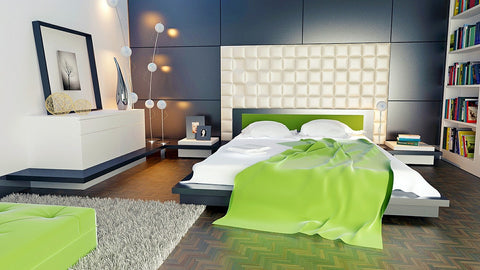
A lot of interior designers are starting to catch on to the versatility of this powerful and alluring color. From the rich luxury of a stately olive tone to the vibrant freshness of a powerful emerald, green has a lot to offer almost any room.
The trick, however, is how you use it.
Just like most colors in your decorating palette, it’s important not to overdo it. While a bright green runner can do wonders for really making your entryway pop, covering each of your walls in the same tone can come off unnerving and tasteless.
It’s no wonder that most people use green more often as an accent color rather than a base. The room pictured above, for example, shows just how much difference a few pieces of bright green accent can really add life and attitude to a space that would have otherwise been cold and lacking personality.
Blending your greens

While making your colors pop is one approach to interior design, another common and effective way of incorporating green into your home décor is by blending it in with similar hues.
Instead of having sharp bursts of color, then, choosing a subtler tone and surrounding it with darker shades like browns, dark yellows, and faded blues can add rich layers of complexity to a space, just like the warm and attractive bedroom pictured above.
Subdued solid colors
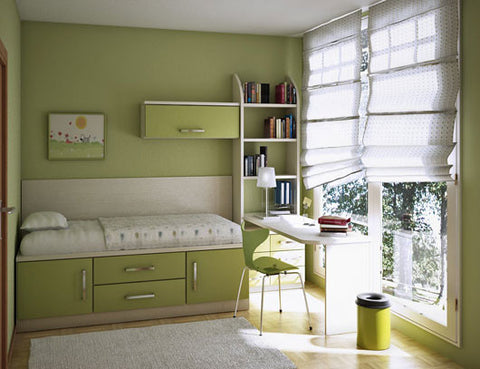
Photo by jingdianjiaju via Flickr
If you do end up deciding to use a solid tone of green for your wall colors, it might be best to go with a more palatable shade like an Avocado, Olive, Fern, or Asparagus Green.
Choosing any of these over the typical accent greens you’ll find can help give your area a powerful sense of character and personality without being disconcerting. Have a look at the children’s room pictured above to get a good idea of what a well selected hue can do for a space.
How to light your greens just right

Photo by charlotte holmes via Flickr
As with any successful interior design scheme, choosing the right type of lighting to get the most out of your greens is crucial. And in order to do that, you need to know the difference between warm and cool lighting.
Color temperature is a way to describe the type of light a lamp gives off. Warmer lights like incandescent bulbs and candles tend to have a richer, more yellow light while fluorescent and halogen bulbs will produce bluer, “cooler” light.
Deciding on what type of illumination fits your design scheme really depends on what kind of personality you want a space to have. Warm tends to be inviting while cool can give an area a more modern feel.
But when it comes to lighting your greens, cool matches up particularly well with bright accent colors while warmer colored temperatures will often do better with the subdued hues.
As with any interior design element though, the best options for lighting are the ones that offer the most flexibility. Dimmer switches, for instance, can help you fine tune your lighting to perfectly accentuate a space without having to buy multiple bulbs with different light outputs.
And beyond that, many smart bulbs offer consumers the ability to change the light color on the fly, giving anyone access to over 16 million different hues to choose from. With that kind of flexibility, you’re sure to find that perfect colored light to really make those greens pop!
Let us know what you think!
How has incorporating green into your design scheme changed your home? What kind of lighting tips do you have when it comes to green décor? Let us know in the comment section below and bring in spring with the Flux Smart product line!
Lighting Tricks To Bring Out The Best In Your Dark Design March 8, 2017 00:00

One of the biggest mistakes you can make when working out your home’s interior design scheme is over-lighting your rooms.
We’ve all been in those kitchens that make you feel like you’re on stage, or those family rooms with lights so bright that it’s more like being in an office building than a warm, inviting space.
This is a particularly common problem when it comes to homes with dark interior design elements. And it seems to make sense, doesn’t it? If you have a lot of dark furniture, all you have to do is even it out with bright lights.
Unfortunately, doing so can really overshadow the striking beauty your darker elements can add to your home. But luckily, there are several lighting tricks specifically for a darker design scheme that’ll really make your décor pop.
So whether you’re trying to illuminate a dim and dramatic entryway, redesigning your shaded bathroom, or working out just the right feel for your moody living room, use the tips below to really get the most out of your dark design scheme.
Fill in the Dark with Extra Design Accents
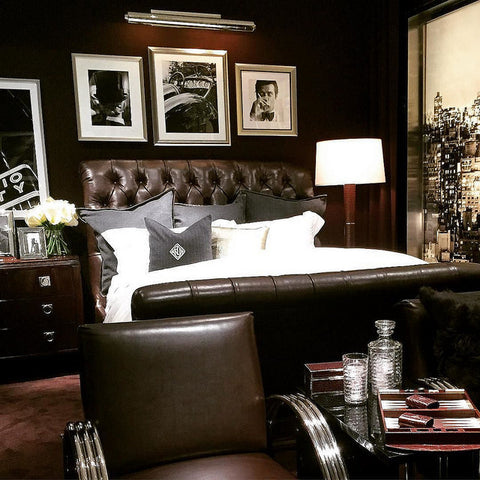
Spaces with a dark design can be especially affected by adding in a lot of accent elements. Part of the reason for this comes from the fact that the darkness creates a great backdrop for the elements due to the natural contrast it creates.
In the bedroom above, for instance, each design element really seems to pop. And when you add the right accent lighting to the equation, you get a dark and dramatic room that looks simply fantastic.
Take Advantage of Natural Light
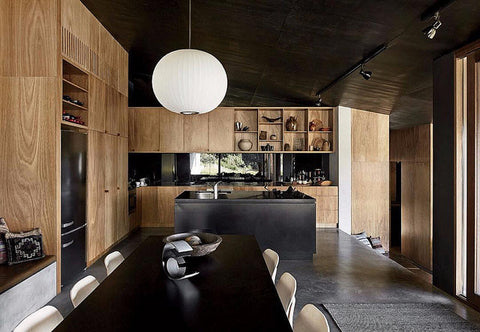
Photo by designmilk via Flickr
If you aren’t taking advantage of your natural light, you’re missing out on one of the best ways to brighten up your home. And that goes double for spaces with dark interior design schemes!
Not only can it help save quite a bit when it comes to your energy cost, it can also bring a certain vibrancy to a room that can counterbalance the dark design elements quite well.
Embrace Low-Lighting
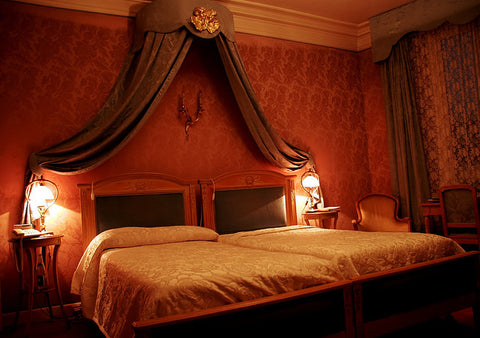
Photo by tec_estromberg via Flickr
As we mentioned earlier, over lighting can lead to a real drain on the energy your rooms are giving off. What’s more, you might be amazed at how little light you actually need to truly bring a space to life. One of the easiest ways to put this to a test is by incorporating dimmers or dimmable smart bulbs into your lighting elements and seeing what lower light can do for a room.
The bedroom above, for example, makes use of just two small accent lights on the end tables to turn what could have been an everyday bedroom into a charming and alluring suite.
Highlight Centerpieces
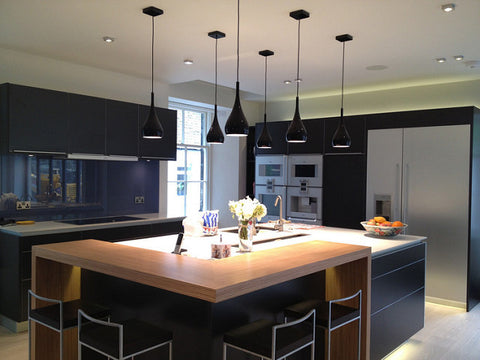
Photo by outreachr.com via Flickr
Drawing the eye towards a certain element in the room is one of the core principles of interior design. Color, form, and uniqueness all go a long way towards this end but when it comes to where the eye instinctively lands upon entering a space, it’s all about the lighting.
As you can see from the largely dark-featured kitchen above, highlighting the center island with bright light builds the rooms character around the centerpiece, not the dark cabinetry. As a result, the kitchen feels light and airy rather than cramped and cloistered.
Bright Light with Dark Furniture

With homes that feature especially dark design elements like the kitchen above, it actually turns out to be far less off-putting to use exceptionally bright lighting. As you can see, this kitchen is bathed in light and yet doesn’t feel “on the spot” like a light-featured space might.
So if your home has particularly dark elements, kicking up the brightness a notch might be just the trick to giving your design the perfect look.
Task Lighting
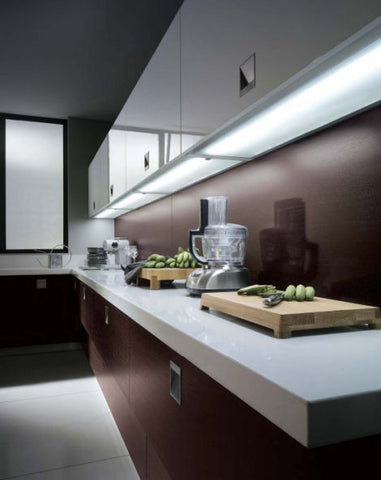
Task lighting is a great way to break up the darkness in your interior design scheme. Not only can it help you brighten up areas that need a bit more light (like the countertops above), they can also create a visually appealing contrast to the surrounding dark areas. Instead of finding ways to brighten up the darkness then, you can embrace it to add more character to a space.
Let us know what you think!
How have you used lighting to turn a dark and gloomy room into one with character and style? Have you tried any of the techniques outlined above and, if so, how did they work for you? Let us know in the comment section below and brighten up your home with the Flux Smart product line!
The Anatomy Of A Smart Bulb: What Makes Them So Special? March 1, 2017 00:00

When it comes to producing light for your home, there aren’t any options out there that’ll save you money like LEDs.
These bulbs use 75% less energy and have 25 times the lifespan of traditional incandescent bulbs and 2-3 times the lifespan of a fluorescent bulb.
And what’s more, with all the research funding from a variety of sources including the Department of Energy, LEDs have never been cheaper!
First and foremost: how does an LED create light?
But how exactly do these amazing bulbs work that make them so much more efficient than other bulbs? Well, the secret is in the fact that LEDs are a type of solid-state lighting, or SSL.
That means that instead of using electricity to heat a tungsten filament in a vacuum (like an incandescent bulb) or applying a current to a gas and then converting that energy to light (like a fluorescent bulb), solid-state lighting is simply applying electricity to a material. The result is less steps between the electricity and the produced light, giving you LED owners out there more efficiency.
It works like this: LEDs, or light-emitting diodes, are built from a semiconductor chip. This chip is made up of material that doesn’t fully conduct electricity or fully insulate from it, but is rather somewhere in between.
This material has both a positively charged part and a negatively charged part to it. What this breaks down to on a molecular level is a part that has electron “holes” (that’s the positive part) and a part that has a bunch of extra floating electrons (that’s the negative part). When you add electricity to the equation, those extra electrons from the negative side will jump into the holes of the positive side, a process which has the side effect of producing light!
The main takeaway from this, though, is the fact that the electricity interacts directly with the material that creates the light and there really aren’t any moving parts in the system. There are heat sinks to take away some of the excess heat from the system (that’s the part that takes up half the bulb and makes them look so different) and covers to the diodes but not a whole lot else! Translation? Less energy loss, more efficiency, and a much nicer looking electricity bill!
How can just one light create over 16 million different colors?
And what about all the different lighting options that high-quality smart bulbs offer the more aesthetic-minded consumers nowadays? How do manufacturers pull that off?
Well this one is actually simpler than you might think. The entire spectrum of visible light that we can pick up with our eyes can be reproduced by the interaction of three colors: red, green, and blue. Anyone out there who has ever fiddled around with their TV’s color settings may have noticed this fact before as you can change the levels of each to create any hue you want.
In a color-changing LED bulb then, each bulb contains three different kinds of colored diodes made up of red, green, and blue. When red combines with blue, you get magenta. Red and green creates yellow (light combinations are different than paint combinations!), and blue with green gives off cyan.
While the interaction between these colors alone can create a wide range and variety of different hues, you still can’t get to 16 million color choices just from these six. And that’s where brightness levels come in. If, say, red is combined with blue but the red light is only displayed at 50% brightness, you get a color in between magenta and blue.
You can see, then, how all of these different variables can add up to one truly versatile color palette that will give you more lighting choices than you’ve ever dreamt of!
How does an LED actually dim and brighten?
Back in the early days of LED development, you may have heard about LEDs being incompatible with dimming switches. And while this inconvenience was definitely true of LEDs at one point, they’ve come a long long way since then. In fact, most smart bulbs today offer not only compatibility with dimmer switches but also the ability to dim these neat little bulbs directly from your smart device. So, what changed between now and then?
The key difference between modern smart bulbs and the LEDs of yore is the implementation of either pulse-width modulation (PWM) or constant current reduction (CCR) which also goes by analog dimming.
PWM is basically an incredibly quick activation and deactivation of the lighting element. So instead of the LED staying on constantly, it achieves a dimmer appearance by quickly turning off and then back on. And while you may be thinking, “why doesn’t it look like they’re blinking?” the answer is that it all happens so quickly that the human eye can’t detect the individual blinks because they’re so fast. Instead, our eyes take the average light levels of the process, making it look like the bulb is actually dimmer. And when you make it even dimmer, that just means the light is turning off more often in any given second. Ingenious solution!
CCR is another method to dim certain LEDs and consists of reducing the power of the current fed to the bulb. This is the traditional method to adjust a bulb’s brightness but only recently have we been able to apply it to LED bulbs.
Combine it all together to create a smart bulb!
Put it all together and throw in a WiFi signal receiver and a microcomputer and you’ve got one of the most technologically advanced pieces of equipment in the home section today: the smart bulb!
Let us know what you think!
What kinds of questions or comments do you have about the anatomy of a smart bulb? Let us know in the comment section below and see the amazing technological achievements that are smart bulbs firsthand at the Flux Smart product section!
